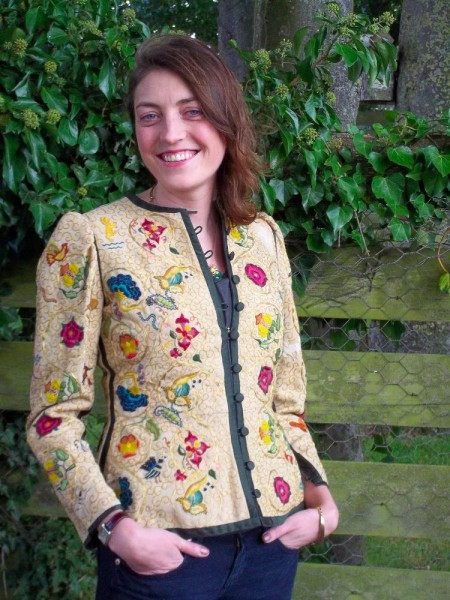
Elizabethan jacket modelled by daughter No 2 and hand embroidered by Mary Addison
How we pride ourselves on being observant and yet how often do we miss what’s right in front of us! Regularly, during my husband’s U3A art appreciation sessions in The Wilson (aka Cheltenham Art Gallery and Museum) he shows slides of paintings I am sure I’ve never seen before yet which he astounds me by saying they are at that very moment hanging in the galleries above our heads. When you consider my passion for embroidered Elizabethan jackets – a passion taken as far as to actually make one myself – it’s even more remarkable that I missed dear little Amy Seymour in her Sunday best. (Click on the link to take you to the first of 5 blogs about making this jacket, which I did whenI was 18.)
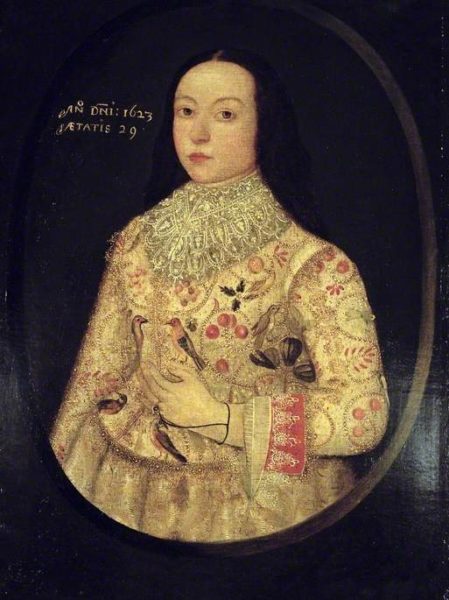
Peake, Robert; Amy Seymour; Cheltenham Art Gallery & Museum; http://www.artuk.org/artworks/amy-seymour-61967
Amy Seymour (1597-1639), the wife of Edward Parker, was painted by Robert Peake or one of his followers in 1623, when she was 29. Her splendid jacket is unusual for the genre in that birds are more prominent than flowers among the curlicues of gold thread. The flowers themselves are indistinct – possibly including honeysuckle and those pink fringed pom pom daisies (though these could be cherries or roses). Amy is obviously partial to a nice bit of lace for she has double lace edged cuffs, gold lace around the bottom of the jacket and along the top of the arm where the bodice joins the sleeve, and the very finest of lace draped around her neck in the manner of a neckerchief, rather than the more usual turn down collar or even ruff which might well have topped such a jacket just 20 or so years before. These jackets were fashionable across the turn of the C17th so it is the accessories that confirm the date of paintings like this. A ruff would suggest Elizabethan while an ornate lace edged collar is firmly Jacobean. This makes sense as a highly decorated jacket would be a treasured possession, handed on in the family and dressed up or down with newly styled collar and cuffs according to the changing fashion.
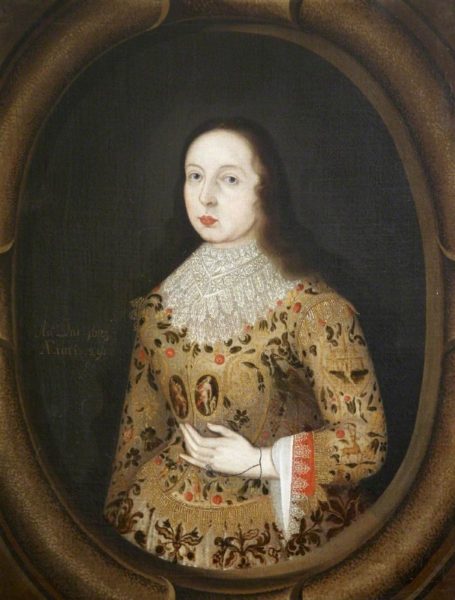
British (English) School; Amy Seymour (1597-1639), Mrs Edward Parker; National Trust, Trerice; http://www.artuk.org/artworks/amy-seymour-15971639-mrs-edward-parker-101055
There is an almost identical second portrait of Amy, also by Peake or a follower and also dated 1623. This can be seen in Trerice, a National Trust house near Newquay. I don’t know which portrait was painted first but that there were 2 should come as no surprise for it was part of Peake’s job as Serjeant Painter to the court of James I of England (from 1707) to produce copies of paintings when required. However, lucky girl Amy seems to have another, quite different but equally ornate jacket. Where the Cheltenham painting has two pairs of bird at the front of the bodice, the Trerice jacket has two cartouches with mythological figures, one very obviously with Cupid and Venus, while the other has a muscular male figure – possibly Mars?. Gold Curlicues are less tightly coiled and distributed differently. The flowers look more like roses, which makes me think those on the Cheltenham painting may be roses too and that perhaps they were part of some personal device specific to Amy. On the sleeve a deer is clearly visible and above it sits what seems like a little ornate pavilion – most unusual. Lace on the edge of the jacket and on the cuffs seems different but the collar appears to be the same. Apart from a slightly more wavy hairstyle, it’s the jackets that cry for attention. Did she say to the painter, Oh forget about little old me, just get my jacket right!
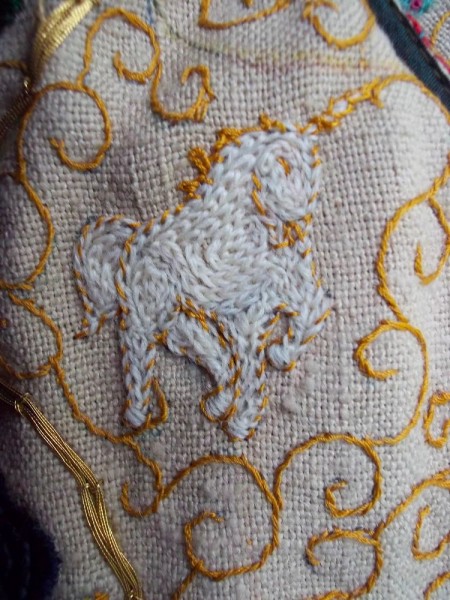
Elizabethan jacket: unicorn (hand embroidered by Mary Addison)
Our U3A group wondered about the wrist cord attached to a ring on her finger. I read somewhere that this was a perfectly usual way of wearing a ring, especially if the ring is a bit too big and liable to slip off. (I should have done this with my wedding ring which, slightly loose verging on very loose in the cold, flew off my hand – I think – when I was sorting the recycling into the bins after Christmas. Hand made, curving to fit under my equally unique engagement ring, we are having to have a replacement made. I feel quite uncomfortable without it. So, next time I’ll have to go for the cord and wrist security device!)
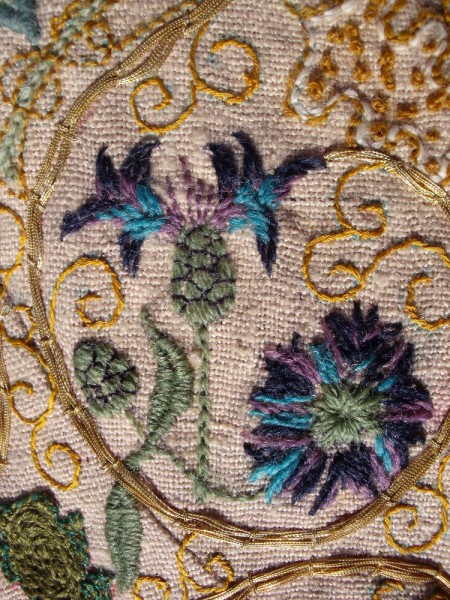
Embroidered Elizabethan Jacket: Cornflower (hand embroidered by May Addison)
The painter, Robert Peake, like the jacket, spanned both Elizabeth’s and James I’s reign. In 1604, he was appointed picture maker to Prince Henry, James I’s heir. He specialised in vibrantly coloured full length costume pieces, unique to the English painters at this time and epitomised in the jewelled miniature enamel portraits of Nicholas Hilliard. Peake’s paintings of the young prince are more dynamic and lively than the usual portraits of the time, yet already his semi naive style was becoming old fashioned and it seems his creativity was collapsing into the formulaic. Interestingly, court accounts show Prince Henry paid more for his tennis balls than for his portraits!(*see below) Prince Henry died in 1612 and Peake moved on to the household of Prince Charles (later King Charles I).
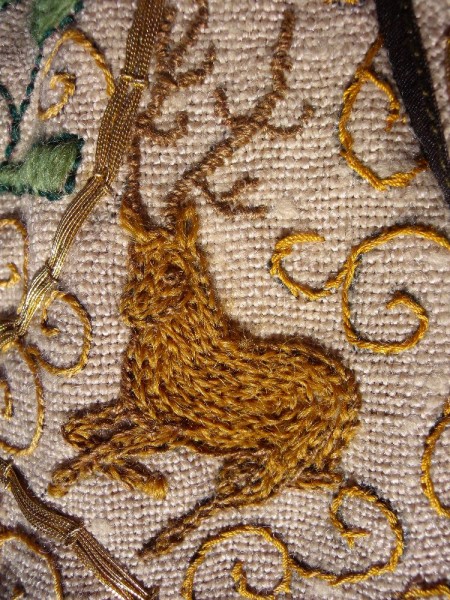
Embroidered Elizabethan Jacket: Stag 9hand embroidered by Mary Addison)
*In Mary Edmond’s book ‘Hilliard and Oliver: Lives and Works of Two Great Miniaturists’, we learn that in October 1608, Peake was paid £7 for “pictures made by his highness command” while in 1609, the prince (Prince Henry) paid £8 for tennis balls in April, £7.10s in May and £8.10s in June.
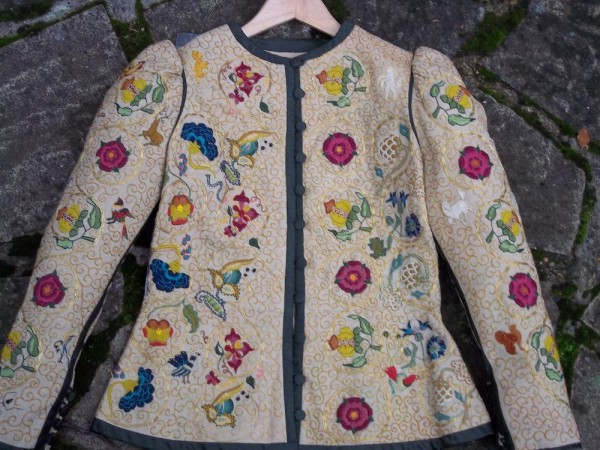
Embroidered Elizabethan Jacket (hand embroidered by Mary Addison)
IT has been a sad week for us, with news of the sudden death of a great and unique friend, Bruce Wannell, who I first blogged about here. Diagnosed with pancreatic cancer only in December, we expected him to live through till at least spring and possibly summer. Friends rallied round and a project began to get those who so desired to each write a short piece about him which he would then ‘edit’, happily going over the part he played in the lives of others, chuckling, tutting and footnoting his way through his few months. A great plan for the perfect death. Well, it didn’t happen like that.
The first many friends knew of his death was when they were rung by his cancer specialist (whose name I hadn’t recognised, so I googled her and discovered she was his doctor!). Womanfully and beyond the call of her professional duty, she was ringing news of Bruce’s death to all the many names in his mobile’s address book. I’m assuming Bruce hadn’t known her for very long but then again, it’s no surprise that he was still able to exert his charm and enviable power to delegate even on his deathbed. Well done Bruce! You will be greatly missed. (Correction. I got this quite wrong and romanticised things hyperbolically. It wasn’ t Bruce’s cancer specialist who rang round but a friend of some years standing. She did, nevertheless, heroically carry out the promised task of going through all the names on Bruce’s phone – and there would have been many – to let them know of his death.)

7 Comments
I’m so sorry to hear of your friend’s death.
I’m very impressed with your Elizabethan jacket!
Kind thoughts, Rachel. Thank you.
So sorry for your loss Mary. I re-read your post about Bruce; what a wonderfully interesting and full life he had. He will surely be missed. I love the Elizabethan jacket with the beautiful embroidery. You’ve posted about this jacket before I think?
Thank you, Nella.
You’re right, I have blogged about the jacket before, back in 2012 (if you want to see more details, click on the text – a passion taken as far as to actually make one myself – in the first paragraph if you want to get to the first of, I think 5 posts about my jacket).
So interesting to read about your own embroidered recreation – well worth the alteration so that it can be worn now I think.
You may know about the Plimoth jacket, which is a recreation from the V & A jackets that you mention in your earlier post. These jackets were studied in detail and all the components were made in as close as possible a fashion to the originals.
The link below is to the exhibition at the Winterthur Museum (in Delaware) where the jacket was displayed. Some of the lacemakers and embroiderers who worked on the jacket – and it took years – were present at the museum to talk about and demonstrate their work.
http://www.arthousegallery.com.au/exhibitions/
Such a lovely idea for your friend and a shame that the plan could not be achieved. I am always sorry to hear lovely things said at funerals, probably never said to the lost ones.
Phil
Phil, Thank you for your comment. I do know the Plimoth Jacket and marvel at the teamwork needed to produce such a marvellous thing. I began my jacket in 1971 in the long vacation from university. The embroidery progressed quite quickly, though it was years before I sewed it up. For sources I must have used visits to the V&A, postcards and books, so I went for reproducing my impression of a jacket rather than copying any one or two jackets too closely. (Why on earth did I have a navy blue ‘pink’/carnation!). I had done no goldwork then so now I shudder to see my squiggly couched gold threads (should have used a frame – though I do hate the distance frames put embroidery at). More recently I have been keeping an eye on paintings with women wearing such jackets (and there are at least 50) and find that though they are broadly similar in design the maker has always opted for individuality, either because she’s wearing a jacket she had a hand in making herself or because the wearer commissioned it that way. There was such fun to be had in the making and wearing of something so unique.
Hi Mary – I just stopped by here having earlier read your wonderful tribute to my brother from 2015. Beautifully written and I think it captures his best qualities. I would also like to congratulate you on your impressive embroidery. Thank you for being a good friend to Bruce. Kind regards from Cape Town